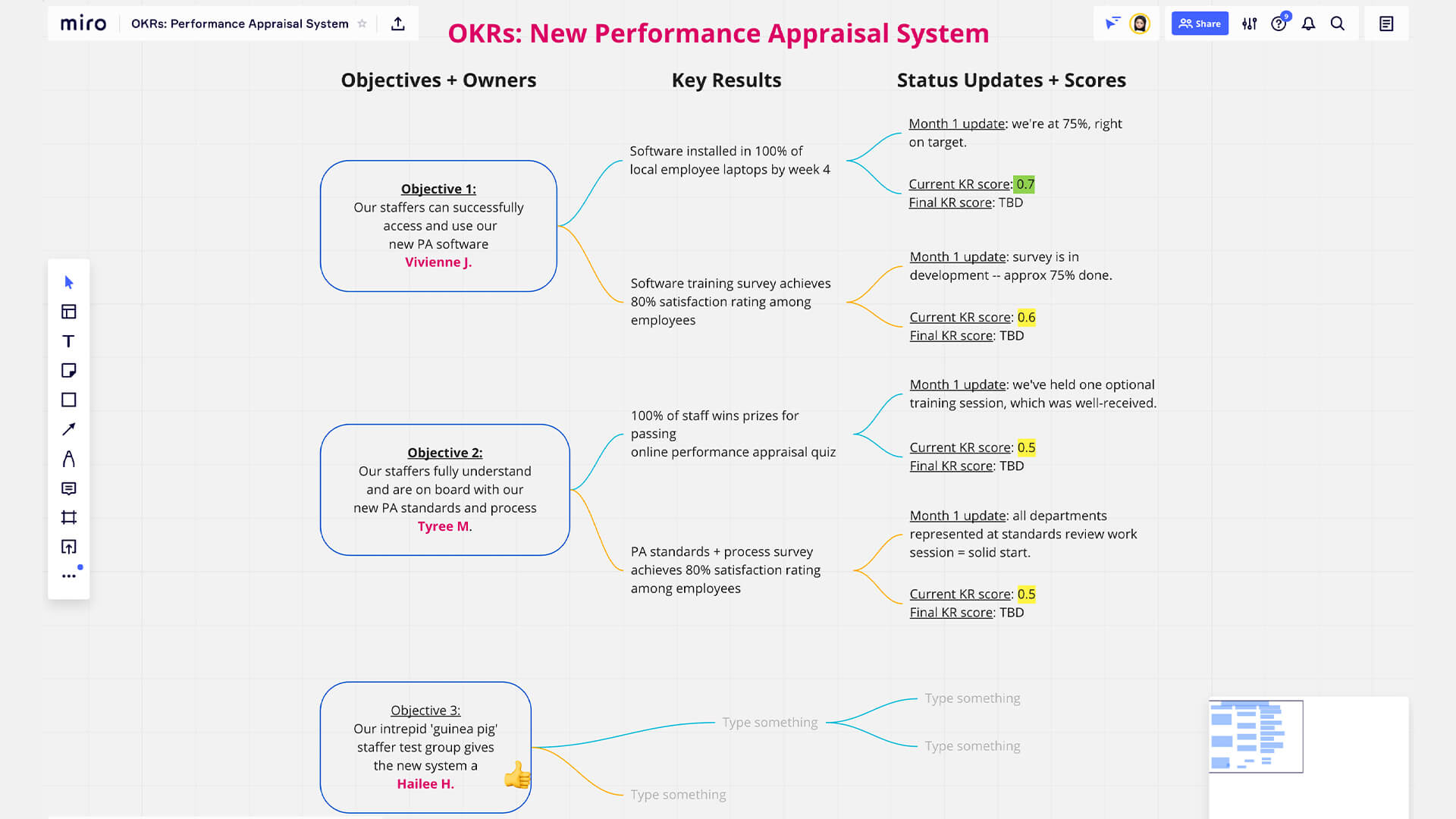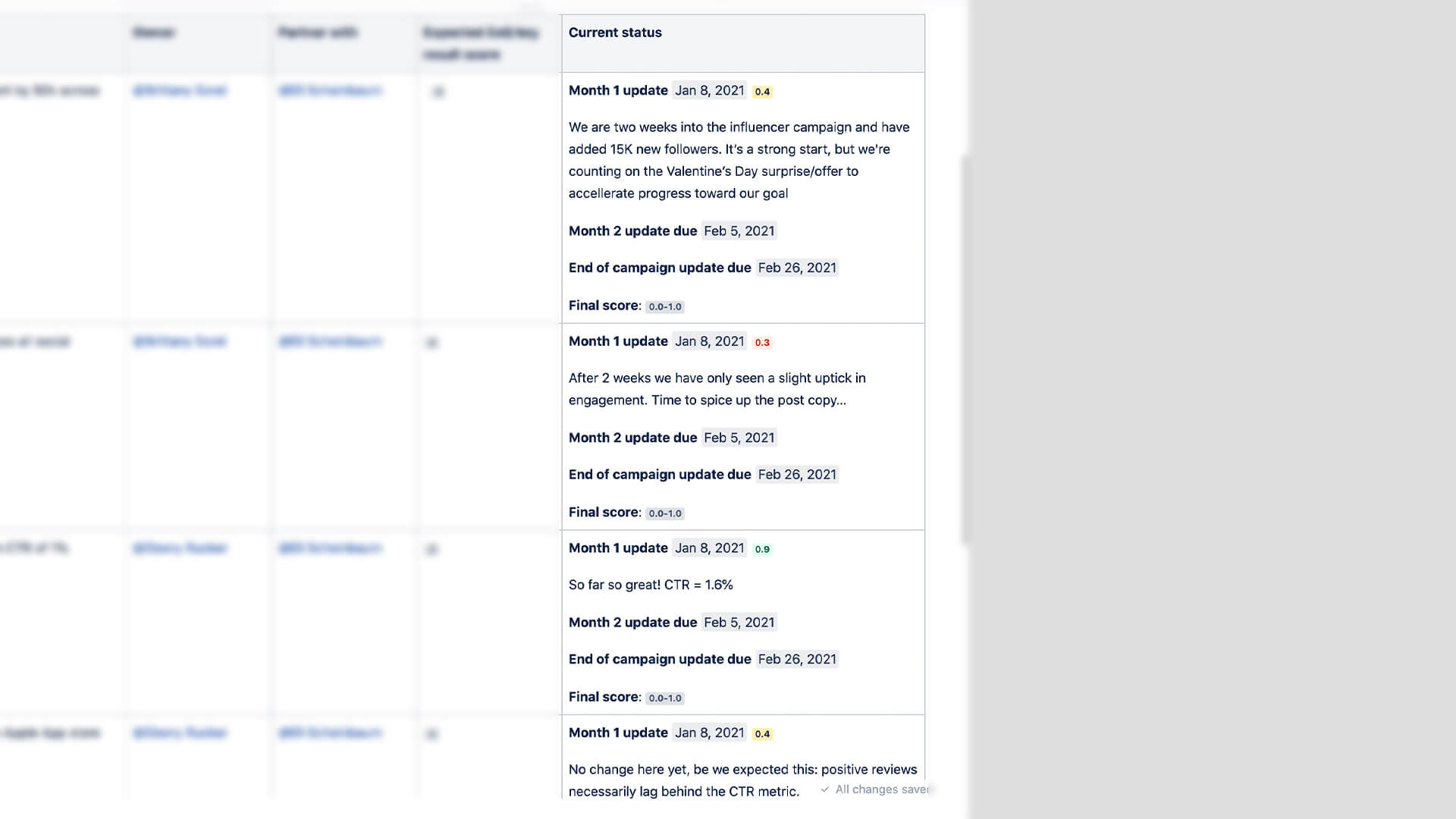OKRs (Objectives and Key Results)
Nutze das OKR-Framework für die Zielsetzung, um Ziele zu definieren, wichtige Ergebnisse zu erzielen und den Fortschritt bei der Erreichung deiner Organisations- und Teamziele zu beschleunigen.

Vorbereitungszeit
10 Mio.
LAUFZEIT
2 Stunden
Teilnehmer
3–11
KURZZUSAMMENFASSUNG
- Definiere 1–3 Ziele.
- Lege 3–5 Hauptergebnisse pro Ziel fest.
- Verfolge den Erfolg und bewerte deine OKRs monatlich.
DAS BRAUCHST DU
- Videokonferenz mit Bildschirmübertragung oder einen Meetingraum
- Tool für die digitale Zusammenarbeit (siehe Vorlagen)
- Stoppuhr oder anderer Zeitmesser
Spiel-Ressourcen
OKRs festlegen
Das Spiel "OKR" besteht aus einem fünfstufigen Prozess, dem jedes Team folgen kann, um Ziele zu definieren, Ergebnisse zu formulieren und den Erfolg mit OKRs zu verfolgen.
Was sind OKRs (Objectives and Key Results)?
John Doerr, der OKRs in seinem Buch Wie Sie Ziele, auf die es wirklich ankommt, entwickeln, messen und umsetzen eingeführt hat, beschreibt das Ziel als das "Was" und die Hauptergebnisse als das "Wie". Darauf gehen wir hier näher ein.
Ziele stehen für das, was du erreichen möchtest, und geben die Richtung vor. Sie sind in der Regel qualitativ, ambitioniert und regen zum Handeln an.
Die Hauptergebnisse beschreiben, wie du die Ziele mit spezifischen, messbaren Resultaten erreichen wirst. Sie sind quantitativ und dienen der Fortschrittsverfolgung bei der Erreichung der Ziele, in der Regel mit klaren Kennzahlen oder Meilensteinen.
OKRs sind am wirkungsvollsten, wenn sie unternehmensweit umgesetzt werden, da sie sich auf alle Teams und Mitarbeiter auswirken.
Was sind die Vorteile eines Spiels zum Thema OKRs?
Hier sind zwei wichtige Gründe, ein OKR-Spiel auszuführen:
- Bestimme, was wichtig ist: OKRs machen deutlich, was Priorität hat und wie deine Arbeit zu diesen Unternehmenszielen beiträgt.
- Bestimme, was nicht wichtig ist: OKRs verdeutlichen, was keine Priorität hat. Sie ermöglichen Teams, sich auf eine begrenzte Anzahl von Prioritäten zu konzentrieren und Aufgaben abzulehnen, die von der Hauptarbeit ablenken.
OKRs richten Teams an Zielen aus, fördern Transparenz, regen dazu an, Verantwortung zu übernehmen, und bieten einen klaren Rahmen für die Erfolgsmessung. Bei korrekter Implementierung sorgen OKRs für eine bessere Leistung und Zusammenarbeit im gesamten Unternehmen.
Wann solltest du OKRs bei der Arbeit verwenden?
OKRs sind besonders nützlich in Zeiten des Wachstums, des Wandels oder wenn es notwendig ist, die Transparenz und Verantwortlichkeit im gesamten Unternehmen zu verbessern. Atlassian-Teams legen jährlich OKRs fest, überarbeiten diese vierteljährlich und verfolgen den Fortschritt monatlich.
3 Vorteile von OKRs
- Positive Wirkung: 83 % der Umfrageteilnehmer stimmen zu, dass OKRs einen positiven Einfluss auf das Unternehmen hatten und weiterhin haben (OKR Impact Report 2022).
- Höhere Produktivität und bessere Zielerreichung: Teams, die für ihre Arbeit Prioritäten festlegen, haben eine 4,6-mal höhere Wahrscheinlichkeit, effektiv und produktiv zu sein (Atlassian State of Teams Report 2024).
- Agilität und Anpassungsfähigkeit: OKRs ermöglichen zügige Zielanpassungen und helfen Unternehmen, sich schnell an Veränderungen anzupassen. Die Bestimmung wichtiger Ziele erhöht die Wahrscheinlichkeit, dass Unternehmen sich anpassen, um das 4,7-Fache (Atlassian State of Teams Report 2024).
1. Das Spiel vorbereiten
Geschätzte Dauer: 10 Minuten
Wenn du mit dem Team zusammenkommst, ob in Person oder remote, erkläre ihnen das Spiel und warum du es durchführst. Erstelle dann ein Dokument für die Zusammenarbeit, z. B. eine Confluence-Seite. Du kannst die bereitgestellten Vorlagen verwenden oder ein eigenes Dokument erstellen.
Lege mit dem Team den Zeitraum fest, für den die OKRs gelten sollen (Quartale sind ein guter Anfang), und teile die folgenden Informationen mit allen Teilnehmern, bevor du das Spiel startest:
- Allgemeine Unternehmensziele und -vorgaben
- Projekt-Roadmaps
- Kundenmetriken und/oder -feedback
-
Frühere OKRs (falls verfügbar)
TIPP: LASST EUCH VON OBEN LEITEN
Wenn dein Unternehmen keine OKRs hat, orientiere dich an den strategischen Initiativen oder übergeordneten Zielen, die für das Jahr im Fokus stehen. Diese sollten die Basis für die OKRs deines Teams darstellen.
2. Ziele definieren
Geschätzte Dauer: 5 Minuten
Lass das Team Ideen zu den besten Zielen sammeln – was sie in einem bestimmten Zeitraum erreichen wollen. Die Ziele sollten qualitativ und ehrgeizig sein und als oberste Priorität eines Teams gelten, bis sie erreicht wurden.
Füge die Ideen dem Dokument für die Zusammenarbeit hinzu. Gruppiert ähnliche Ziele und fasst die Ideen dann in 1–3 Zielen zusammen.
1. Kundenzufriedenheit verbessern
2. Produktentwicklung beschleunigen
3. Marktreichweite ausbauen
4. Teamproduktivität erhöhen
5. Zukunftsfähigkeit stärken
6. Begeistern und überzeugen
7. In ein KI-Unternehmen verwandeln
8. Engagement für Prioritätsprodukte steigern
9. Nutzung durch Business-Teams ausweiten
10. Umsatz erhöhen
3. Hauptergebnisse festlegen
Geschätzte Dauer: 10 Minuten
Um den Fortschritt zu messen, sollte jedes Ziel drei bis fünf entsprechende Hauptergebnisse (KRs) haben. Dabei handelt es sich um quantitative Kennzahlen, die detailliert beschreiben, wie die Ziele erreicht werden.
Beantwortet dafür Fragen wie diese: "Was muss getan werden, damit dieses Ziel erreicht wird?" Gibt es Lücken, die geschlossen werden müssen? Wenn wir alle Hauptergebnisse erzielen, erreichen wir dann dieses Ziel?
Best Practices für das Festlegen von Hauptergebnissen:
- Spezifische und messbare Ergebnisse definieren
- Ambitionierte, aber erreichbare Ziele setzen
- Ergebnisorientierte, nicht aktivitätsbasierte Ziele festlegen
- Ressourcenverfügbarkeit sicherstellen
- Zustimmung des Teams einholen
- Überwachen und bei Bedarf anpassen
1. Ziel: Kundenzufriedenheit verbessern
- Hauptergebnis 1: Net Promoter Score (NPS) von 50 oder höher erreichen
- Hauptergebnis 2: Durchschnittliche Antwortzeit für Kundenanfragen auf unter 2 Stunden reduzieren
-
Hauptergebnis 3: Kundenbindungsrate um 10 % steigern
2. Ziel: Produktentwicklung beschleunigen
- Hauptergebnis 1: Bis Ende des 4. Quartals zwei neue Funktionen veröffentlichen
- Hauptergebnis 2: Durchschnittliche Fehlerbehebungszeit um 25 % verringern
-
Hauptergebnis 3: Prozentsatz automatisierter Tests auf 80 % erhöhen
3. Ziel: Marktreichweite ausbauen
- Hauptergebnis 1: Bis Ende des Jahres drei neue geografische Märkte erschließen
- Hauptergebnis 2: Markenbekanntheit in den Zielmärkten um 20 % steigern
-
Hauptergebnis 3: Partnerschaften mit fünf wichtigen Influencern oder Unternehmen sichern
TIPP: ERGEBNISSE STATT AUFGABEN
Hauptergebnisse sind eine Messgröße für die Arbeit, nicht die Arbeit an sich."5 Webseiten erstellen" ist Arbeit.
"5 % mehr Seitenaufrufe erzielen" ist ein Hauptergebnis.
TIPP: QUALITÄT SICHERN
KRs sollten Ergebnis und Qualität erfassen. Wenn ein KR zum Beispiel die Anzahl der gelösten Helpdesk-Tickets ist, könntest du auch den Rückgang der eingereichten Tickets messen, um sicherzustellen, dass die Qualität des gebotenen Supports erhalten bleibt. Das Ziel ist nicht, Qualitätsabstriche zu machen, um KRs zu erreichen.
4. Verantwortliche zuweisen
Geschätzte Dauer: 10 Minuten
Weise jedem Hauptergebnis einen Verantwortlichen im Team zu. Das Hauptergebnis gehört zwar dem gesamten Team, aber der Verantwortliche ist für die Verfolgung des Fortschritts zuständig.
5. Fortschritt verfolgen mit OKRs
Geschätzte Dauer: 15 Minuten
Überprüft den Fortschritt eurer OKRs einmal pro Monat. Bewertet, wie ihr auf dem Weg zu den einzelnen Zielen vorankommt.
Punktzahl: Ein Wert zwischen 0 und 1, der widerspiegelt, ob ihr die Zielvorgabe im Hinblick auf die Hauptergebnisse verfehlt, fast erreicht oder tatsächlich erreicht habt. Zum Beispiel:
0,3 = Wir haben das Ziel verfehlt
0,7 = Wir waren sehr nah dran
1 = Wir waren erfolgreich. Vielleicht sollten wir uns in Zukunft schwierigere Ziele setzen.
Es wird empfohlen, ambitionierte Ziele festzulegen, und es ist okay, nicht jedes Mal ein perfektes Ergebnis zu erzielen. Bei der Bewertungsphilosophie von Atlassian liegt der Schwerpunkt auf ehrgeizigen Zielen. Für die Punktzahl 0,7 sollte eine 80:20-Chance bestehen, das Ziel zu erreichen, und für 1,0 sollte die Chance bei 50:50 liegen.
Nachbereitung
Teilen
Speichere deine OKRs an einem Ort, an dem sie dein Team und deine Stakeholder leicht finden können. Beende das Quartal mit einer abschließenden Bewertung für jedes Hauptergebnis. Überdenkt in einer Retrospektive eure OKRs und Verbesserungsmöglichkeiten bei der nächsten Festlegung von OKRs.

Hast du noch Fragen?
Komme mit anderen Benutzern des Atlassian Team-Playbook ins Gespräch, hole dir Unterstützung oder gib Feedback.
Andere Spiele, die dir gefallen könnten
Entscheidungsfindung
DACI-Framework zur Entscheidungsfindung
Weise klare Rollen zu, um eine effektive Zusammenarbeit und ein Verantwortungsgefühl während des Entscheidungsprozesses sicherzustellen.
Entscheidungsfindung
Kompromisse
Definiere und priorisiere deine Projektvariablen.
Zielsetzung
Strategische Fokusbereiche modellieren
Baue die strategischen Fokusbereiche deiner Organisation auf und richte sie aus.
Bleibe auf dem neuesten Stand.
Melde dich für unseren Newsletter an, wenn du über neue Spiele informiert werden und Tipps für besseres Arbeiten erhalten möchtest.










